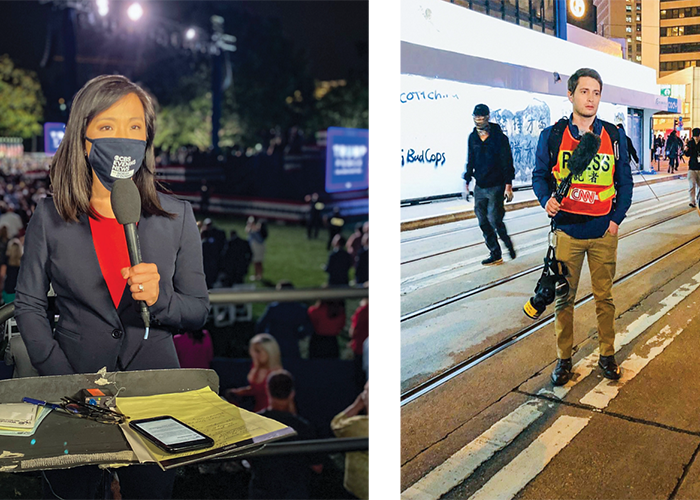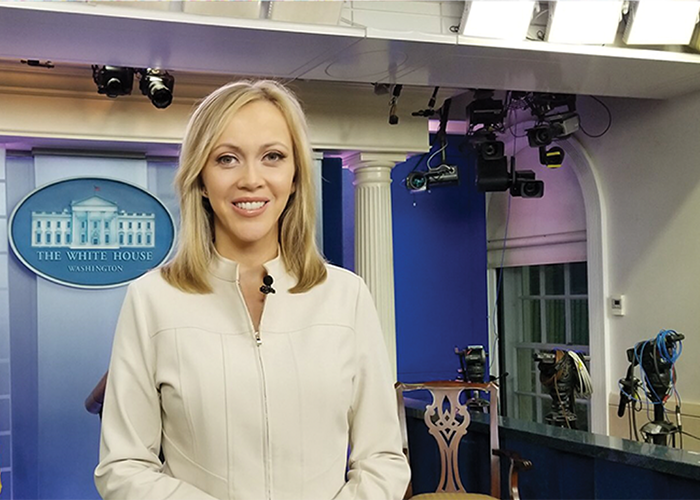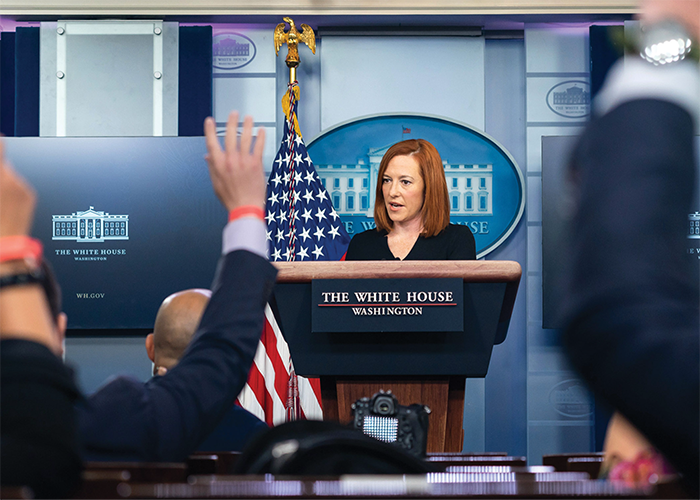“It was pure luck that I ended up at William & Mary, but I had an incredible experience,” she says.
When not studying for her English and sociology classes, she was involved across campus — varsity swimming, working as a tour guide, interning in the Admission office, volunteering, and serving as president of her sorority, Chi Omega. Conspicuously absent from that list, however, is work in politics and communications.
That shift came in 2002, two years after she graduated, when Psaki broke up with her boyfriend (don’t worry, she says, they’re on good terms), packed her car, and drove to Iowa to work for the state Democratic Party.
“That was a big turning point for me,” she says. “Obviously I learned I loved politics.”
Her next turning-point-turned-road-trip came in February 2007, when she received an offer to work for then-Sen. Barack Obama’s first presidential campaign. A week later she started in Chicago, and in less than two years she was working in the White House communications office.
Over the next 10 years, she went from deputy communications director to President Obama’s 2012 campaign press secretary to spokesperson for the State Department to White House director of communications. Late last year she joined then President-Elect Joe Biden’s transition team. The rest is history — even if, to Psaki, the reality didn’t sink in at once.
“I don’t know if there wasn’t one moment when it hit me, but obviously the realization that you’re being seriously considered for a job like the U.S. press secretary is a huge honor,” she says. “I think it was really when it was announced where it felt real.”
It certainly felt real her first day on the job. Even if she’s worked in the West Wing before, Psaki says, her first White House briefing was altogether different.
“You just think of the enormous weight of the opportunity, but also the responsibility,” she says. “I remember thinking I can mess up other days, but today I really don’t want to mess up.”
Standing behind the lectern, Psaki reads the room and cycles through each reporter’s questions, including those that come from a different ideological background. While responding, she tries to remember that the reporters in the room aren’t the only ones listening. Whether watching live or after the fact, the entire American public may scrutinize what she says.
Sometimes she thinks over questions later in the day. Sometimes she wishes she answered them differently. That’s part of the job.
Yet the high stakes and the high scrutiny are also highly rewarding. Psaki still sometimes marvels at the chance to walk through the White House halls or chit-chat with the president on Air Force One. At times during the Obama administration, she was too focused on work to enjoy that surreal feeling. She’s trying to pay more attention this time around and enjoy her short moment in history while she’s still in it.
That can involve occasional catch-ups with Florida Rep. Stephanie Murphy ’00, a former sorority sister, or explaining to her 5-year-old niece that while she can see “Aunt Jen” on TV, Aunt Jen can’t see her.
Interactions like those help give her peace as she performs one of the world’s most stressful jobs and raises two young children. Her best friends — all from William & Mary — also help. Even at work, she keeps reminders of where she met them, and where she got her start, close by. A picture of the Wren Building hangs on her office wall.
 Jiang’s workdays in her home office start with a similar memento: a William & Mary Christmas ornament sitting on her desk. Like Psaki, she followed a similarly unlikely journey to Williamsburg.
Jiang’s workdays in her home office start with a similar memento: a William & Mary Christmas ornament sitting on her desk. Like Psaki, she followed a similarly unlikely journey to Williamsburg.
Moving from China to America at the age of 2, Jiang grew up in small-town Buckhannon, West Virginia, which nurtured her affection for the outdoors. By her senior year of high school, she’d applied to almost 20 colleges, but only William & Mary felt like what she wanted in a home.
“When I stepped foot on campus, I felt like this is what college is supposed to be,” she says. “It’s sort of a magical place.”
The university met her family’s financial needs and provided scholarships for her to study as a Monroe and William & Mary Scholar. All in all, the decision ended up being easy.
Much harder was her decision to enter journalism. Her entire life, Jiang’s father had wanted her to become a doctor. She even started her first year on the pre-med track, majoring in chemistry. But the more time she spent with her pre-med classmates, the more she realized she didn’t share their enthusiasm. She didn’t want a career of going through the motions, and she knew the line of work where that wouldn’t happen.
When she was 13, Jiang won a national competition with Channel One News, a since-closed company that fostered youth media literacy, with alumni from Anderson Cooper to Lisa Ling. Channel One flew her out to Los Angeles for a weeklong media summit. Jiang was amazed.
“For me, it was just mind-boggling that this could be your job because it seemed like so much fun,” she says.
That impression remained true in her time at William & Mary, as she wrote for the Flat Hat and co-starred on an amateur news broadcast with a friend named Luther Lowe ’06 — who 10 years later exited the friend zone and eventually became her husband. Jiang switched her major to philosophy and applied to a graduate program in journalism her junior year.
Then, as now, there was no journalism major at the university. But Jiang avers that her philosophy degree was the best preparation available.
“I actually think the liberal arts education is the best education to have in your pocket as you try to enter journalism,” she says. “For me, the number one quality a journalist possesses is a curiosity for learning, and I think William & Mary really nurtured that.”
Like her time at William & Mary, her hours are long and her work is intense. Especially during the pandemic, when accurate information is a matter of life and death, missing a briefing is like missing a class. Completing all the make-up work required can feel like unrolling a snowball.
As she did in Williamsburg, Jiang responds to the pressure through the comfort of friends and family. She’s a bit shy, and oddly enough for a broadcast reporter, she doesn’t like to be the center of attention. So, when she’s on air, she doesn’t think of the overwhelming number of viewers watching from afar. Instead, Jiang focuses on herself and the cameraperson and says whatever she thinks her mom would want to know.
As an immigrant, one story with particular resonance for her has been the rise in hate crimes against Asian Americans over the last year. Since reports of violence and discrimination emerged following COVID-19’s arrival in the U.S., Jiang has tried to keep the focus on the issue through her work.
That effort often involves swimming upstream in a river of misinformation around the pandemic. But Jiang is used to hard work — “even if I’m not working, I’m working,” she says — and hard questions, sometimes directed to her fellow alumna, Psaki, in the briefing room.
That doesn’t mean she’s not proud to have a William & Mary graduate on the other end of the podium.
“It is inspiring to see we have that representation,” Jiang says. Then again, “You don’t have to look very far to find us everywhere in Washington.”
For a few years, Jiang didn’t have to look outside her office. She’s not the only William & Mary alumna who has recently covered the White House — not even the only member of the Class of 2005.
 From 2018 through 2020, Jiang’s partner on the White House beat at CBS was Paula Reid ’05, whose shared experience at the university laid the foundation for a friendship and reporting partnership on one of journalism’s biggest stages.
From 2018 through 2020, Jiang’s partner on the White House beat at CBS was Paula Reid ’05, whose shared experience at the university laid the foundation for a friendship and reporting partnership on one of journalism’s biggest stages.
“Weijia and I would divide and conquer important sources and break news,” Reid says. “It was really fun to work with someone I consider a friend, and who I gelled with really well professionally.”
Since her time at William & Mary, Reid has enjoyed teamwork. She was a member of Kappa Kappa Gamma sorority, she volunteered to coach a youth basketball team, and she taught an always full Pilates class three times per week at the recreation center.
But it was the diversity on campus and critical thinking skills she learned at the university that kickstarted her circuitous road to journalism. Initially, Reid thought she wanted to be a lawyer, enrolling in Villanova University’s Charles Widger School of Law after graduation. Midway through her time there, she says, she caught the “journalism bug.”
“I was at a professional event and I saw a legal affairs journalist giving a speech and just thought, ‘That’s what I want to do,’” Reid says.
By the time she decided on a career change, she had already accepted a yearlong clerkship in Wilmington, Delaware. So, while riding the train there and back, she would plan how to pursue her dream, while balancing a personal life and onerous student loans.
Her answer came in the form of a self-described “geriatric internship” (because she was older than most interns) at CBS’ investigative unit in New York after the clerkship concluded. For half a year, she took the bus from Philadelphia to New York five days a week, all to work without pay.
“I was supposed to go on to a fancy private law firm,” Reid says. “Instead, I got an internship and I just loved it.”
By the summer of 2010 she had earned a job as a production secretary and soon after became a digital journalist. In 2014, after moving to Washington to cover the Justice Department, she began breaking so much news she got opportunities on air and found a home in broadcast journalism.
Her work, particularly on Special Counsel Robert Mueller’s investigation into Russian interference in the 2016 election, drew her into the White House’s orbit. So many stories involving the Trump administration had a legal component that her expertise as a lawyer became an indispensable asset — leading to her transition to a CBS White House correspondent in 2019.
“I have prosecutorial training and I brought it to the White House, particularly when we were covering the pandemic,” Reid says. “I bring a lawyer mentality to the front row.”
To her, that style involves rigorous, factbased questions similar to a cross-examination. It sometimes leads to tense exchanges, but it’s nothing personal, she says. Especially amid a public health emergency, information matters.
But while her time in the briefing room was the most visible part of her job, it was a small part of her day-to-day schedule.
“The White House is one of those jobs that sort of looks glamorous on the outside,” Reid says. “On the inside it’s certainly a privilege, but it’s not glamorous. We work in these cramped spaces. There are long days. You can’t often leave.”
At one point, after being exposed to COVID-19 while in the briefing room last year, Reid had to quarantine for two weeks at home. Continuing their coverage during that time was yet another example of how resilient and team-oriented the White House unit at CBS was. She may often be the one asking the questions on camera, but a whole team works behind the scenes to make that possible.
“One of the things that I really take away from the past year is how collaborative our CBS team was and how collaborative the White House reporters as a whole were,” says Reid, who has since joined CNN as a senior legal affairs correspondent. “Journalism was so essential in trying to get out accurate information to people who had never been through anything like this.”
About the time when Reid would finish her shift in the evening, David Culver ’09, an international correspondent at CNN’s Beijing bureau, would be starting his.
Culver’s days start early, often before 5 a.m. He checks in with his family stateside, often having lively conversations with his Cuban mother. Next comes a workout, followed by coffee, and the workday begins.
Starting with Hong Kong and ending with New York, Culver watches the ebb and flow of news cycles around the world. By the time he’s done combing through emails and appearing on air, it can be difficult to find enough hours to sleep. But he has to, because come tomorrow morning the long wave of worldwide news begins again.
The path from growing up in Fairfax County, Virginia, to working in Beijing is a long one, and for Culver it was paved with accidents. But never up to question was his commitment to journalism. He decided on the field, and television journalism in particular, when he was around 12 years old and his cousin passed away. As local reporters interviewed his relatives, he saw an art in their poise during the most difficult of moments.
Thinking he wouldn’t get in, Culver turned in his application to William & Mary two days late and without the optional essay. As if from providence, he was accepted.
Determined to enter his field, Culver received a full-time offer from WAVY, the NBC affiliate in Hampton Roads. But he was still just 21 and had a year left of college. He and the station worked out a schedule. Culver would work weekends and whenever he wasn’t in class, driving the hourlong commute each way.
His first big story came when he conducted on-air interviews with baggage handlers facing layoffs at a local airport. Days later, they called back in tears saying their jobs — and hundreds of others across the country at the same airline — had been saved.
“I remember thinking there’s some real power there, not for me in particular, but for the outlet that we have in journalism to bring things to light that could bring positive change,” Culver says.
At WAVY, Culver went from digital writer to tech reporter to news reporter to producer to anchor. After a few years he transitioned to WRC, the NBC affiliate in Washington. Following a similar enterprising path, he went from Northern Virginia reporter to anchor to national reporter, where he covered major stories ranging from the Parkland school shooting in Florida to the thawing of Cuban-American relations.















 Jiang’s workdays in her home office start with a similar memento: a William & Mary Christmas ornament sitting on her desk. Like Psaki, she followed a similarly unlikely journey to Williamsburg.
Jiang’s workdays in her home office start with a similar memento: a William & Mary Christmas ornament sitting on her desk. Like Psaki, she followed a similarly unlikely journey to Williamsburg. From 2018 through 2020, Jiang’s partner on the White House beat at CBS was Paula Reid ’05, whose shared experience at the university laid the foundation for a friendship and reporting partnership on one of journalism’s biggest stages.
From 2018 through 2020, Jiang’s partner on the White House beat at CBS was Paula Reid ’05, whose shared experience at the university laid the foundation for a friendship and reporting partnership on one of journalism’s biggest stages.